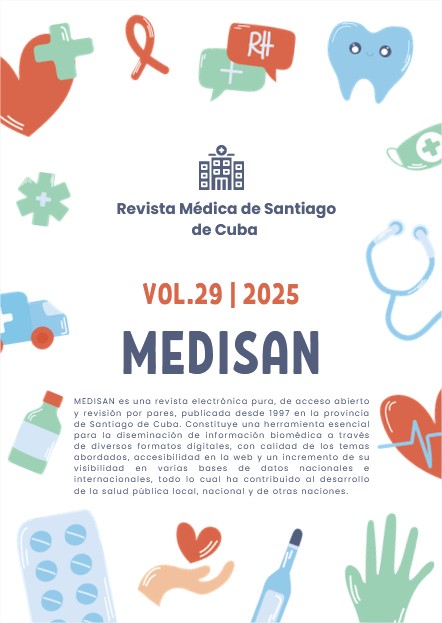Clinical and epidemiological characterization of young people living with HIV/AIDS
Abstract
Introduction: There is a high proportion of young people infected with HIV/AIDS who are unaware of their clinical condition and are diagnosed late, making the body vulnerable to the appearance of coinfections and comorbidities associated with AIDS.
Objective: To characterize the population of young patients living with HIV/AIDS in Santiago de Cuba according to selected epidemiological descriptors, clinical manifestations and humoral parameters.
Methods: An observational, descriptive, cross-sectional study was carried out in young people diagnosed with HIV/AIDS in Santiago de Cuba, during the period January 2018 to December 2022. The sample was constituted by 282 patients. It was considered as temporary horizon for the general analysis of the provincial incidence, the new diagnoses of the illness understood among the years 2003-2022.
Results: The highest incidence was recorded in the last year of the five-year period, with a predominance in the 20-24 age group, with single marital status and secondary education. It was noted that 53 young males (75.7%) they had transactional sex,the pneumonia predominated as an opportunist disease (29.6%), and the most frequent coinfection was the anal condyloma (10.6%). A marked increase in the disease was identified in this subpopulation, with epidemic peaks in 2013, 2014, and 2022.The mortality showed evident tendency to the descent (1.0%) of the total.
Conclusions: The risk of HIV/AIDS transmission in young people is high, hence the importance of continuing research in this highly vulnerable group.
Downloads
References
1. Arias Pavesio C. Programa de Educación para la Salud: Prevención del VIH en adolescentes en el barrio de Kariobangui, Nairobi,Kenia. [Tesis]. Valladolid-España: Universidad de Valladolid. ;2024 [citado citado 19/03/2025].41 p. Disponible en: https://uvadoc.uva.es/bitstream/handle/10324/68286/TFG-H3142.pdf?sequence=1&isAllowed=y
2. Fondo de las Naciones Unidas para la Infancia. América Latina y el Caribe: diariamente 30 adolescentes y jóvenes se infectan por primera vez con VIH. Cuba: UNICEF; 2023 [citado19/03/2025]. Disponible en: https://www.unicef.org/cuba/comunicados-prensa/vih-adolescentes-america-latina-caribe
3. Sánchez L. Que para el año 2030 el VIH/SIDA no sea un problema de salud en Cuba. Periódico Granma. [citado19/03/2025]. 2022 nov 30. Cuba: [aprox. 2 p.]. Disponible en: https://www.granma.cu/cuba/2022-11-30/que-para-el-ano-2030-el-vihsida-no-sea-un-problema-de-salud-en-cuba-30-11-2022-20-11-28
4. Fondo de las Naciones Unidas para la Infancia (UNICEF). Prevención del VIH/sida en Cuba. Datos de la Encuesta de Indicadores Múltiples por Conglomerados. 2019 [citado 25/03/2025]. Disponible en: https://www.unicef.org/cuba/media/4876/file/Folleto%20Prevenci%C3%B3n%20del%20VIHsida%20en%20Cuba.pdf
5. Joint United Nations Programme on HIV/AIDS. Young People and HIV. UNAIDS. 2021 [citado25/03/2025]. Disponible en: https://www.unaids.org/sites/default/files/media_asset/young-people-and-hiv_en.pdf
6. Ceballos Rojas MA, Hernández García F, Delgado Montesinos L, Romero Lantarón AM, Abad Sastre AM, Lazo Herrera LA. Conocimientos y percepción de riesgo de estudiantes de Estomatología frente al VIH/sida. Educación Médica Superior. 2022 [citado 25/03/2025];36(1):e2504. Disponible en: https://www.medigraphic.com/pdfs/educacion/cem-2022/cem221d.pdf
7. UNAIDS. Young People and HIV. 2021 [citado 25/03/2025]. Disponible en: https://www.unaids.org/sites/default/files/media_asset/young-people-and-hiv_en.pdf
8.Rodríguez Puga R, Pérez Díaz Y, Dueñas Rodríguez Y. Características sociodemográficas y epidemiológicas de adolescentes diagnosticados con VIH / SIDA. Arch Hosp Univ Gen Calixto García. 2022 [citado 25/03/2025];10(3). Disponible en: https://revcalixto.sld.cu/index.php/ahcg/article/view/e1005/897
9.HIVinfo.NIH.gov. El VIH y las poblaciones específicas. El VIH y Adolescentes y Adultos Jóvenes HIVinfo. 2025 [actualizada 15/4/25; citado 20/7/25]. Disponible en: https://hivinfo.nih.gov/es/understanding-hiv/fact-sheets/el-vih-y-los-adolescentes-y-adultos-jovenes
10.Rodríguez Gutiérrez M, Fernández Rodríguez C, Laguno M. Factores influyentes y conductas de riesgo relacionadas con el VIH en jóvenes adolescentes. Revista Multidisciplinar del Sida. 2024 [citado30/03/2025];10(27). Disponible en: https://www.revistamultidisciplinardelsida.com/factores-influyentes-y-conductas-de-riesgo-relacionadas-con-el-vih-en-jovenes-adolescentes/
11.Bossonario PA, Ferreira MRL, Andrade RLP, Sousa KDL, Bonfim RO, Saita NM, et al. Risk factors for HIV infection among adolescents and the youth: a systematic review. Rev. Latino-Am. Enfermagem. 2024 [citado 30/03/2025];30(spe):e3696. Disponible en: https://pmc.ncbi.nlm.nih.gov/articles/PMC9647917/pdf/1518-8345-rlae-30-spe-e3697.pdf
12.Ministerio de Salud Pública. Plan estratégico Nacional para la prevención y control de las ITS, el VIH y las hepatitis 2019-2023. La Habana; 2019.
13.Ministerio de Salud Pública. Plan estratégico Nacional para la prevención y control de las ITS, el VIH y las hepatitis 2024-2028. La Habana; 2023.
14.Puente Sani V, Besse Díaz R, Martínez Cantillo L. Clinical Immunological and Psychopathological Manifestations in HIV/AIDS Patients. Biomed J Sci & Tech Res. 2021 [citado30/03/2025];38(1). Disponible en: https://biomedres.us/pdfs/BJSTR.MS.ID.006096.pdf
15.de la Paz Bermúdez Tania, García González Idorkis, Capó de Paz Virginia, Portela Ramírez Daniel, Jiménez Pérez Narciso A, Calderón Sandubeti Enrique et al. Hallazgos radiológicos de la neumonía por Pneumocystis jirovecii en fallecidos cubanos con VIH/sida. Rev Cubana Med Trop. http://scielo.sld.cu/pdf/mtr/v72n2/1561-3054-mtr-72-02-e512.pdf
16. Ortiz Espinoza M, Laguna Torres A. Neumonía por Pneumocystis jirovecii como debut
del síndrome de inmunodeficiencia adquirida (SIDA)en épocas de pandemia por COVID-19,reporte de un caso. Interciencia méd. 2023 [citado 30/03/2025];13(2):79-83. Disponible en: https://core.ac.uk/download/pdf/586345994.pdf
17.Guo XY, Qu MM, Wang X, Wang ZR, Song JW, Yang BP, et al. Characteristics of blood immune cell profile and their correlation with disease progression in patients infected with HIV-1. BMC Infect Dis. 2023 [citado 01/04/2025]; 23(1):893. Disponible en: https://pmc.ncbi.nlm.nih.gov/articles/PMC10731693/pdf/12879_2023_Article_8847.pdf
18.Zhou C, Zhang W, Lu R, Ouyang L, Xing H, Shao Y, et al. Higher Risk of Mortality and Virologic Failure in HIV-Infected Patients With High Viral Load at Antiretroviral Therapy Initiation: An Observational Cohort Study in Chongqing, China. Front Public Health. 2022 [citado 01/04/2025];10:800839. Disponible en: https://pmc.ncbi.nlm.nih.gov/articles/PMC8851314/pdf/fpubh-10-800839.pdf
19.Govender RD, Hashim MJ, Khan MA, Mustafa H, Khan G. Global Epidemiology of HIV/AIDS: A Resurgence in North America and Europe. J Epidemiol Glob Health. 2021 [citado 01/04/2025]; 11(3):296-301. Disponible en: https://pmc.ncbi.nlm.nih.gov/articles/PMC8435868/pdf/JEGH-11-3-296.pdf
20.Fondo de las Naciones Unidas para la Infancia. 80 adolescentes morirán por sida cada día hasta 2030. UNICEF. 2018 [citado 01/04/2025]. Disponible en: https://www.infosalus.com/salud-investigacion/noticia-unicef-80-adolescentes-moriran-sida-cada-dia-2030-20181129121332.html
Published
How to Cite
Issue
Section
License
Copyright (c) 2025 MEDISAN

This work is licensed under a Creative Commons Attribution 4.0 International License.
All the articles can be downloaded or read for free. The journal does not charge any amount of money to the authors for the reception, edition or the publication of the articles, making the whole process completely free. Medisan has no embargo period and it is published under the license of Creative Commons, International Non Commercial Recognition 4.0, which authorizes the copy, reproduction and the total or partial distribution of the articles in any format or platform, with the conditions of citing the source of information and not to be used for profitable purposes.





